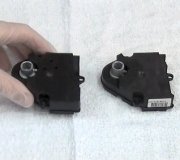Unfortunately, the only way to know if the system has a full charge of refrigerant is to look in a sight glass on the receiver / drier under the hood, but those are only found on older Chrysler products. If you see vapor bubbles flowing through the glass, it's low on charge. You can add refrigerant just until those bubbles stop appearing.
Ford used a sight glass too in the 1980s and later, but they do not work. There will still be vapor bubbles in the glass when the system is fully charged.
For all other brands, the only way to know an AC system is fully charged is to recover what is in there now, then pump in the measured amount called for. As I mentioned, that will cause the evaporator in the dash to be filled halfway with liquid and half with vapor. There are people who will tell you they can determine the state of charge by watching the two gauges connected to the low and high-side service ports, but that can't be relied on either. When the system is at rest, the pressure throughout it will be very close to ambient temperature. That's just a lucky coincidence with refrigerant, but it works in our favor.
Suppose it's 80 degrees outside today. You will find the low and high-side pressures in the system will be close to 80 psi, but only when there is some liquid and some vapor in there. If you bleed off some of that pressure, logic would dictate the pressure should drop, and it will, ... At first. Stop here and think of the pressure cap on the radiator, or the pressure cooker you cook food with. Water boils at 212 degrees, but cooling systems can get much hotter than that. By using a pressure cap, the boiling point of water increases three degrees for every pound of pressure. Most caps hold up to 15 psi on the system. That increases the boiling point by 45 degrees to 257 degrees. This is also why the coolant comes gushing out when the cap is removed while the engine overheating. That coolant might be at 230 degrees, for example, but when the pressure is removed, it instantly vaporizes, expands hundreds of times, and blows out as steam.
Similarly, refrigerant boils at a real low temperature, somewhere around minus 50 to minus 80 degrees, as I recall. It stays in liquid form when it's under pressure. Back to our story, if there's 80 psi in the system, with some liquid and some vapor, if you bleed off some vapor, the pressure drops. Some of the liquid turns to vapor and expands as it does. That drives the pressure right back up to 80 psi. If you bleed off some more vapor, more of the liquid turns to vapor, and the pressure goes right back to 80 psi. That will keep on happening until the point is reached when there's no more liquid left to turn to vapor. It's at that point the pressure will drop when more vapor is released, just like letting air out of a bicycle tire. If you go by the gauge readings, you'll find normal pressures even when most of the refrigerant has leaked out. All that's needed with the system running is to have enough liquid left that there's liquid flowing through the expansion valve. That can leave the evaporator empty of liquid. The "cold" develops back where the liquid is turning to vapor. If that is under the hood, the evaporator won't cool the air blowing through it.
If this doesn't help, consider starting a new question specific to your vehicle. First, unlike on other sites where anyone can chime in to confuse the issue, this became a private conversation between just two or three people. This question has gone "off the list" of questions waiting for a reply, so none of the other experts are going to see your addition. That might not get you the help you need. When you start a new question, you're likely to get help from someone more qualified or familiar with your model.
The second problem has to do with how these get categorized so others, like you, researching a similar problem can search by system, (heating and AC), or by brand and model. Your new question will be found by others when searching for Honda solutions. This can help others in the future.
If there's no need to start a new question, please keep me updated on what you find or what the solution turns out to be.
Thursday, March 30th, 2023 AT 2:24 PM


